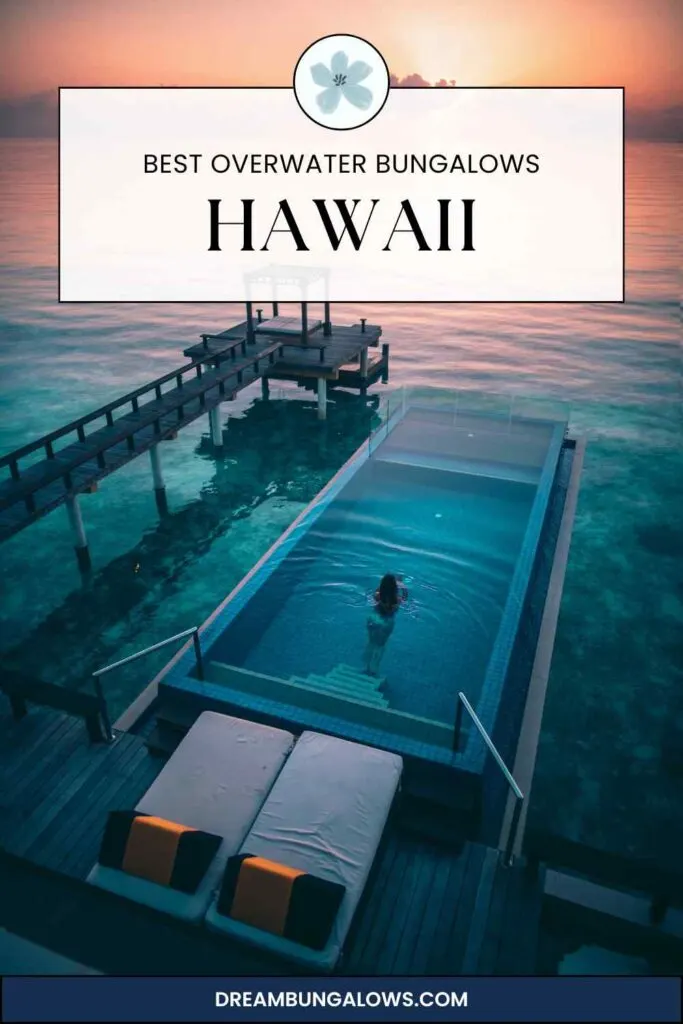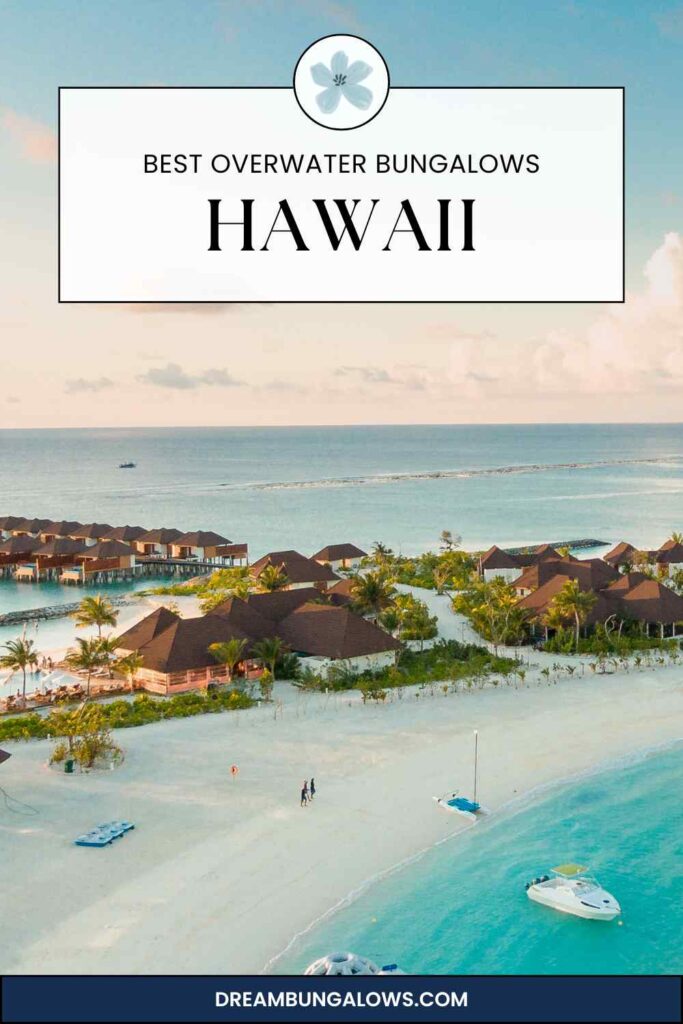Dreaming of waking up to gentle waves lapping beneath your private bungalow? Hawaii, with its mesmerizing beaches, is often top of mind.
But does the Aloha State actually offer that iconic overwater bungalow experience?
Let’s dive in and explore Hawaii’s unique take on luxurious waterside stays.
The Enduring Allure of Overwater Bungalows
Overwater bungalows symbolize the height of tropical luxury. Imagine stepping off your private deck into turquoise water, surrounded by coral reefs and colorful fish.
For couples craving a romantic hideaway or anyone seeking a peaceful break from everyday life, these accommodations often top bucket lists.
In truth, real stilted bungalows are nowhere to be found in the Aloha State, even if many travelers arrive expecting them.
So how did the assumption grow that Hawaii must have them?
Part of it is marketing.
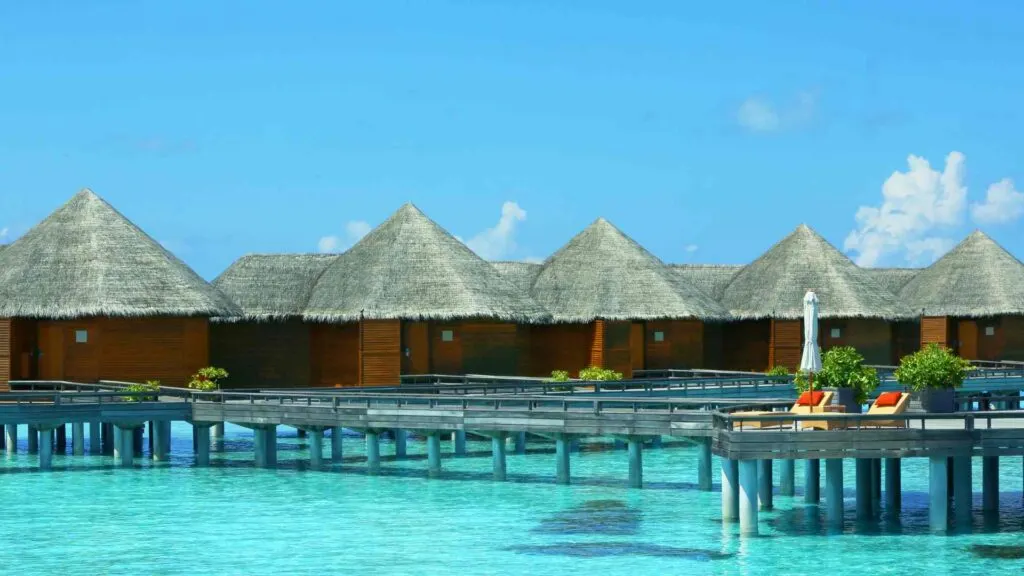
Resorts highlight oceanfront or lagoon-facing rooms, sometimes phrased to spark images of huts floating above water.
Then there’s the logic that “if Bora Bora has them, why wouldn’t Hawaii?” But Hawaii’s environment, regulations, and cultural perspectives have steered development in different directions.
Still, there are “almost-overwater” options that come very close to replicating that sublime experience of being one step from the sea.
Below, we explore the history behind Hawaii’s missing overwater bungalows, local properties offering near-water bliss, and even suggestions on where to find genuine overwater huts if you can’t resist that dream.
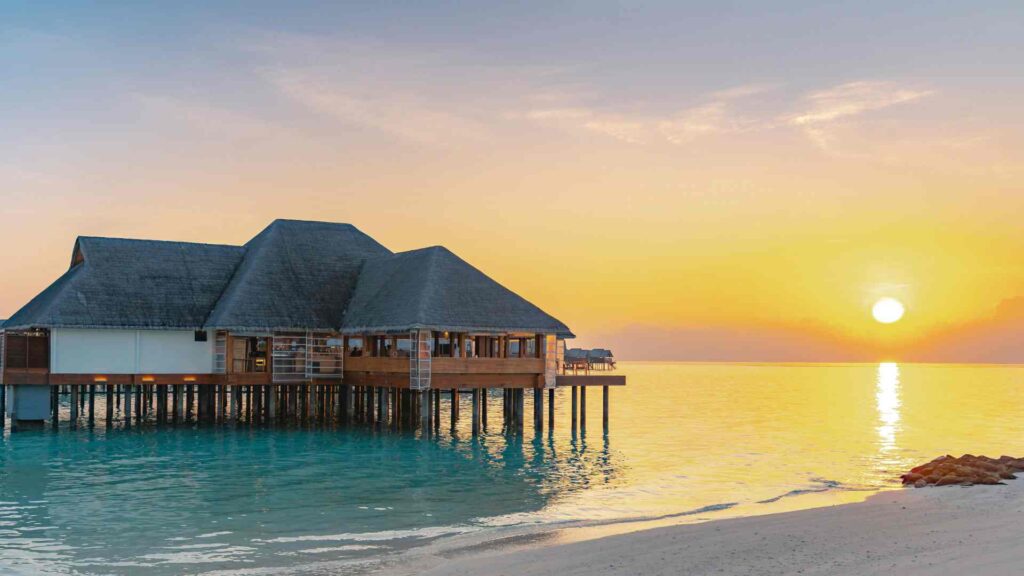
Why Hawaii Lacks Traditional Overwater Bungalows
Hawaii is a global travel hotspot with postcard beaches, mighty volcanoes, and a fusion of cultures.
If any place could sustain profitable overwater resorts, it’s this chain of islands. Yet, these classic bungalows never quite took hold. Here’s why:
1. Environmental Regulations and Marine Protections
Hawaii fiercely protects its reefs and marine habitats. Constructing stilted accommodations over delicate coral or sea life can lead to damage.
Strict laws limit what can be built near shorelines to prevent ecological harm.
Unlike certain other tropical destinations, Hawaii rarely grants leeway for large overwater structures that might threaten marine sanctuaries or infringe on public beach use.
2. Coastline and Wave Patterns
Many iconic overwater bungalow locales—such as Bora Bora—feature calm lagoons shielded by reefs.
Hawaii’s shorelines, however, often experience rough surf and strong currents. Building a stilted property in such conditions can be structurally challenging and costly, not to mention risky during storms or high surf seasons.
3. Cultural and Community Considerations
Hawaii isn’t just a tourist playground; it’s a deeply sacred place for Native Hawaiians. Shorelines hold cultural importance, and much of the area is regarded as public land.
Creating a series of private huts over these waters could spark backlash from local communities dedicated to preserving cultural values and ensuring beach access for everyone.
4. Storm and Hurricane Risks
Hawaii does face occasional hurricanes and seasonally big waves. Overwater properties in high-impact zones would require expensive reinforcement and constant maintenance.
The added complexities—insurance costs, storm safety measures, environmental disruption—make it less appealing for developers to attempt these unique accommodations.
Because of these reasons, the classic thatched-roof bungalows on stilts simply never emerged in Hawaii. But this doesn’t mean you’re doomed to regular hotel rooms.
Hawaii has its own brand of near-water luxury that gets extremely close to the overwater vibe—minus the literal stilts.
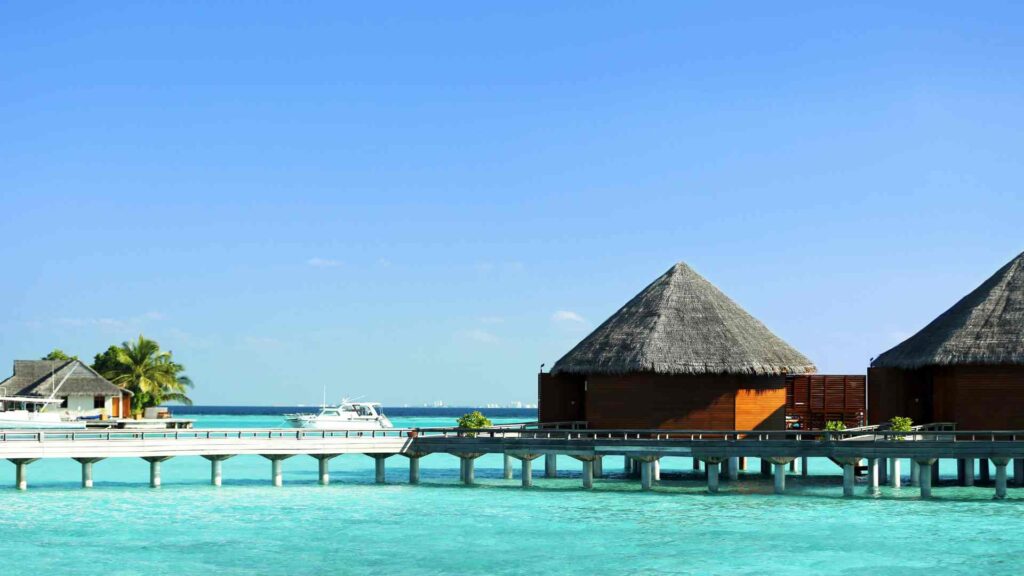
The “Almost-Overwater” Experience in Hawaii
Whether you’re celebrating a honeymoon or just want that special “I’m almost in the ocean” feeling, Hawaii’s “almost-overwater” accommodations can tick many of the same boxes.
While you won’t get the direct ladder-to-the-lagoon setup, you’ll still be lulled to sleep by waves and can often walk a few paces for a snorkel or swim.
Private Villas and Oceanfront Cottages
- What to Expect: High-end interiors, large decks, sometimes even personal plunge pools.
- Where to Find Them: Upscale resorts on Maui, Oahu’s Ko Olina coast, and the Kohala Coast on the Big Island.
- Traveler Tip: Search for oceanfront rental homes as well—some stand literally steps from secluded coves, giving you near-bungalow exclusivity.
Lagoon-Facing Rooms in Resort Complexes
- What to Expect: Man-made lagoons are typically calm, perfect for leisurely swimming, paddleboarding, or snorkeling.
- Where to Find Them: Ko Olina on Oahu is famous for such setups. Many big-name resorts there design rooms to face these tranquil waters.
- Traveler Tip: If you want to avoid big waves, these lagoons are your best bet. They combine gentle waters with scenic surroundings.
Cliffside Hideaways
- What to Expect: Dramatic ocean views, especially on Kauai’s North Shore or parts of the Big Island. You’re not over the water, but perched so close you’ll see waves pounding below.
- Where to Find Them: Princeville (Kauai) for majestic cliffside accommodations, and certain spots along the Big Island’s coast.
- Traveler Tip: Some properties feature pathways down to hidden beaches and tide pools—perfect for snorkeling and discovering marine life away from crowds.
These options don’t place you directly above the water, but they deliver a similar sense of closeness. One visitor recalled how “the waves felt almost within arm’s reach,” describing the setting as “a bungalow vibe without the overwater label.”
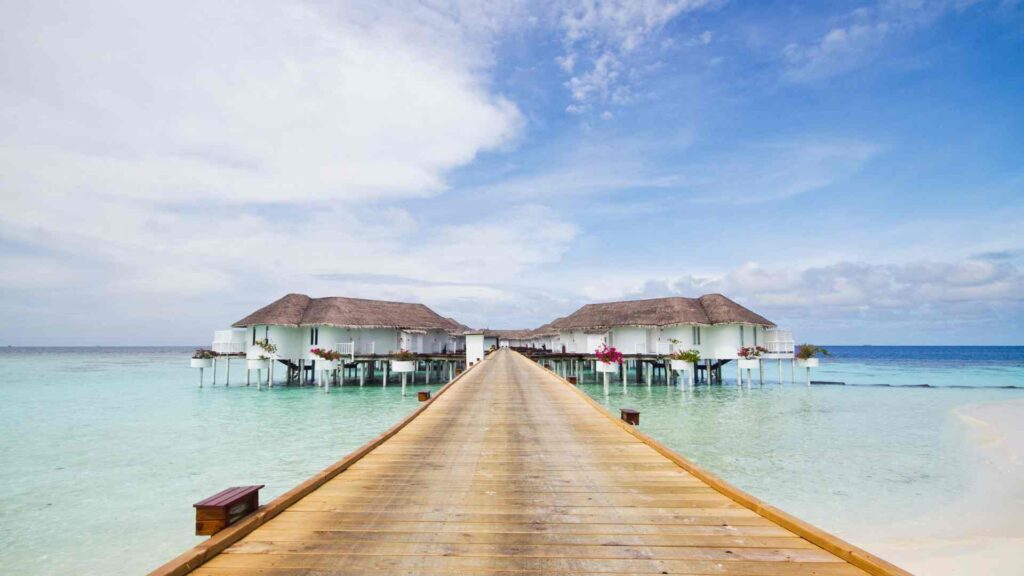
Top Hawaiian Picks for Near-Overwater Stays
If you’re looking to nail down a specific location, here are standout regions and properties often lauded for their ocean proximity, comfort, and mesmerizing views.
Oahu: Ko Olina Lagoons
- Resorts: Four Seasons Oahu at Ko Olina, Aulani, A Disney Resort & Spa
- Why It’s Great: Sheltered lagoons minimize waves, making them ideal for swimming and snorkeling. Nearby shops and restaurants add convenience.
- Local Perks: Easy access to Honolulu sights and North Shore surf culture if you want day trips or nightlife.
Maui: Wailea and Kapalua
- Resorts: Four Seasons Resort Maui, Grand Wailea, Montage Kapalua Bay
- Why It’s Great: Plush villas, top-notch spas, and postcard-perfect beaches. Wailea’s gentle surf appeals to families, while Kapalua often boasts scenic coves.
- Local Perks: Diving at Molokini Crater, the scenic Road to Hana, and plenty of golf courses for sporting enthusiasts.
Kauai: Princeville
- Resorts: 1 Hotel Hanalei Bay (formerly Princeville Resort), various private villas
- Why It’s Great: Stunning cliffside locations with sweeping vistas of Hanalei Bay’s turquoise waters and verdant mountains.
- Local Perks: Lush jungles, dramatic hiking trails (including the famous Kalalau Trail), and a quieter, “Garden Isle” vibe.
Big Island: Kohala Coast
- Resorts: Four Seasons Resort Hualalai, Mauna Lani, Auberge Resorts Collection
- Why It’s Great: Beautiful shoreline with pockets of calm water near lava rock, plus an upscale yet low-key atmosphere.
- Local Perks: Access to unique landscapes, from volcanic terrain to black-sand beaches, plus top-tier golf courses.
At each location, you might find stand-alone cottages or suites right by the water, with design that maximizes ocean views.
Contact the resort or property host directly to confirm how close to the ocean your unit is and whether you’ll have unobstructed views.
Best Times to Book for Prime Oceanfront Bliss
Hawaii’s climate is famously mild year-round, but certain seasons can elevate your near-water experience.
- Winter (December to April)
- Pros: Whale-watching peaks; hearing whales breach from your lanai is surreal.
- Cons: High season means bigger crowds and higher rates. Some beaches might have rougher waves.
- Shoulder Seasons (April to June, September to November)
- Pros: Fewer crowds, pleasant weather, potentially more availability for prime oceanfront spots.
- Cons: Rain can vary, though typically sporadic. Still less crowded than peak months.
- Summer (June to August)
- Pros: Sunny days, calmer waters on certain coasts, family-friendly vibe.
- Cons: Another peak for tourism, so prices rise again and lodging can sell out quickly.
If your vacation plan is flexible, aim for shoulder months. They often merge favorable weather, slightly lower prices, and fewer crowds—ideal for snagging the best near-water spot without intense competition.
Eyeing True Overwater Bungalows? Nearby Destinations to Consider
If your heart is set on that classic, stilted-over-lagoon imagery, Hawaii’s “almost-overwater” might not suffice. In that case, consider venturing a bit farther to the South Pacific. With an extra flight or two, you can be in:
Bora Bora (French Polynesia)
- Highlights: Legendary turquoise lagoons, overwater huts with direct access to coral reefs, and views of Mount Otemanu.
- Top Resorts: Four Seasons Bora Bora, St. Regis Bora Bora, Conrad Bora Bora Nui
- Visitor Praise: “Paradise realized” is a common refrain, with many praising the unmatched clarity of the lagoon.
Moorea (French Polynesia)
- Highlights: A more laid-back alternative to Bora Bora, but still home to gorgeous overwater resorts.
- Top Resort: Hilton Moorea Lagoon Resort & Spa
- Visitor Praise: Many find Moorea more “local” and less commercial, with abundant marine life.
Tahiti (French Polynesia)
- Highlights: Gateway island with some overwater options, though overshadowed by Bora Bora’s popularity.
- Top Resorts: Various, often near the capital, Papeete.
- Visitor Praise: Proximity to local life and markets, plus a diverse dining scene.
Fiji
- Highlights: Generally known for pristine beaches, crystal waters, and famously warm hospitality. Some islands do feature genuine overwater bungalows.
- Top Areas: Mamanuca or Yasawa Islands.
- Visitor Praise: People rave about the cultural immersion, friendly locals, and reef adventures.
You can combine a Hawaii trip with a short hop to French Polynesia or Fiji. Some travelers split their vacation: a few days soaking in Hawaii’s culture and activities, then a flight to Bora Bora or Moorea for that dreamlike overwater finale.
Hawaii vs. Bora Bora: A Quick Comparison
Weighing your options between a fully immersed overwater experience and Hawaii’s dynamic offerings? Consider these comparisons:
Scenery & Culture
- Hawaii: Varied terrain—volcanoes, waterfalls, lush forests, big-city life in Honolulu, and strong Native Hawaiian traditions mixed with Western influences.
- Bora Bora: Smaller scale, more remote, with an emphasis on lagoon life and relaxed island culture. Rich French Polynesian heritage in dance, music, and cuisine.
Activities
- Hawaii: Surfing, hiking (think Na Pali Coast or Volcanoes National Park), luaus, robust nightlife in Waikiki, plus day trips between islands.
- Bora Bora: Water-centric—snorkeling, diving, lagoon tours, and beach relaxation. Fewer on-land attractions, but impeccable marine experiences.
Accommodations
- Hawaii: A broad spectrum—from budget-friendly condos to lavish oceanfront resorts, but no true overwater bungalows.
- Bora Bora: Specializes in luxurious stilted villas, often with private plunge pools and direct sea access.
Expense
- Hawaii: Can be pricey in peak times, but there are mid-range options and frequent flight deals from the U.S.
- Bora Bora: One of the world’s costliest destinations, with flights and overwater villas commanding premium rates. It’s often a once-in-a-lifetime splurge.
Which to Choose?
If you crave culture, varied landscapes, and a more extensive itinerary, Hawaii shines. If your priority is that iconic “bungalow over a turquoise lagoon,” Bora Bora is unbeatable. Many travelers do both—Hawaii for exploration, Bora Bora for pure overwater retreat.
Practical Tips for Booking a Near-Water Hawaiian Stay
1. Aim for Oceanfront or Deluxe Ocean-View Categories
- Request specific rooms or villas closest to the shore.
- Ask about potential obstructions (like palm trees) that might block your view.
2. Consider Private Rentals
- Platforms like Airbnb or VRBO can reveal cottages perched above tide pools or next to secluded coves.
- Read reviews carefully for honest insights on proximity to water and privacy levels.
3. Join Hotel Loyalty Programs
- Major chains in Hawaii (Four Seasons, Marriott, Hilton) have rewards.
- Points or status can yield better rooms or upgrades, helpful for locking down premium views.
4. Research Resort Maps
- Properties often share site layouts on their websites. Study them to pick the building or wing closest to the water.
- Follow up by calling the resort to confirm your choice.
5. Book Early for Peak Seasons
- Whale-watching and holiday periods fill up quickly.
- If you want to ensure that prime near-water spot, advance planning is key.
6. Check Seasonal Surf Conditions
- If you’re staying on Oahu’s North Shore in winter, expect higher waves—great for surfers, less so for casual swimmers.
- For calmer water, places like Ko Olina or South Maui are safer bets year-round.
Embracing Hawaiian Culture During Your Stay
Hawaii’s magic goes beyond your hotel room or bungalow equivalent. The islands’ cultural richness, known as the spirit of aloha, is a huge part of why people return again and again.
- Attend a Luau: Sample traditional foods like kalua pork, poi, and haupia while watching hula and fire dances that tell ancient Hawaiian legends.
- Try Hula: Many resorts offer short lessons. You’ll gain a deeper appreciation for the graceful, storytelling dance central to Hawaiian culture.
- Taste Local Produce: Farmers’ markets are brimming with fresh papaya, pineapple, lychee, and more. Support local farmers while discovering new flavors.
- Explore Historical Sites: Visit Iolani Palace on Oahu, the only royal palace on U.S. soil, and delve into the rich narrative of Hawaiian royalty.
- Be a Respectful Visitor: Avoid stepping on reefs, leave no trace on trails or beaches, and learn about local guidelines to protect ecosystems.
Hawaii invites you to slow down, connect with nature, and engage with its traditions. Overwater or not, the true highlight often lies in these cultural and natural experiences.
The Appeal of Island-Hopping in Hawaii
If you’re torn between different accommodations, consider island-hopping to sample each island’s personality:
- Oahu: Urban energy in Honolulu, laid-back surf culture on the North Shore, historical landmarks like Pearl Harbor.
- Maui: Romantic beaches, diverse marine life, scenic drives along the Road to Hana, and the sunrise spectacle at Haleakalā.
- Kauai: Lush “Garden Isle” with dramatic cliffs, waterfalls, and a slower pace of life.
- Big Island: Active volcanoes, black-sand beaches, and stargazing on Mauna Kea.
- Lanai or Molokai: Quieter escapes, fewer tourists, a glimpse of old-school Hawaii.
Inter-island flights are relatively short, and each island has unique accommodation styles. You could stay near-water on one island, then move on to a different environment on another. This approach satisfies curiosity about the entire archipelago while letting you find the lodging experiences that resonate most.
Nearby Overwater Bungalows: Worth the Extra Travel?
Yes, if your dream stay requires that iconic hut-on-stilts setting, places like Bora Bora or Moorea deliver. They’re about five to six hours south of Hawaii by plane—an extra step, but for many, an essential pilgrimage to the heart of overwater paradise. Yet Hawaii remains a prime vacation choice for cultural depth, varied landscapes, and wide-ranging activities.
Some travelers adopt a “split stay” strategy:
- A week in Hawaii: Explore islands, indulge in near-water lodgings, soak in local culture.
- Hop to Bora Bora: Spend a few nights (or more) in the dreamlike overwater bungalow.
This combination can yield a once-in-a-lifetime journey that marries the excitement of Hawaii’s diversity with the indulgence of a purely overwater escape. Just remember to budget appropriately; overwater villas in Bora Bora can be among the most lavish (and expensive) accommodations on the planet.
Conclusion
Hawaii’s reputation for dreamy getaways is well-earned, but it might come as a surprise that true overwater bungalows—the stuff of glossy travel magazines—don’t exist in the Aloha State.
Environmental concerns, cultural reverence for the land, coastal characteristics, and local regulations all explain why. Instead, Hawaii offers an “almost-overwater” experience that charms visitors in countless ways.
From luxurious cliffside villas with panoramic ocean views to lagoon-facing suites steps from gentle water, you’ll find the gap between the sea and your doorstep delightfully small.
Real travelers confirm that Hawaii’s unique atmosphere and warm aloha spirit compensate for the lack of huts on stilts.
The synergy of volcanic landscapes, Polynesian heritage, and a robust tourism infrastructure ensures each island has its own flavor of magic.
You’ll encounter experiences—like watching humpback whales breach at sunrise or learning hula under swaying palm trees—that you’d be hard-pressed to find anywhere else.
For those absolutely set on waking up over a shimmering lagoon, destinations like Bora Bora, Moorea, or Fiji are just a flight (or two) away.
They offer the famed overwater bungalow fantasy in all its glory: thatched roofs, glass panels revealing passing fish below, and ladders leading directly into the sea.
Pairing such an excursion with a Hawaiian vacation can be the ultimate tropical blend—two distinct but equally mesmerizing journeys.
In the end, deciding between “almost-overwater” in Hawaii or “actual-overwater” in the South Pacific comes down to preference.
Hawaii promises variety and a rich cultural tapestry, while Bora Bora and friends promise that quintessential stilted existence above turquoise shallows.
Whichever path you choose, you’re guaranteed ocean breezes, serene horizons, and the gentle roar of waves, reminding you that life is sweeter when it’s spent near the sea.
Embrace Hawaii’s near-water opulence or set your sights on the South Pacific’s iconic bungalows—either way, the ocean is your constant companion, and the tropical sun your endless source of warmth.
The only question left is: Which island paradise will you explore first?
